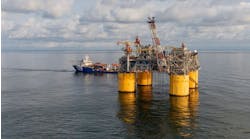A type of flange gasket has been used in high-pressure cathodic protection systems for many years, but until recently, few operators were aware of the use of the product (Pikotek) in conventional piping applications. YPF Maxus Southeast Sumatra has operated with the product since Widuri field operations were taken over by YPF Maxus in 1997 through the acquisition of Maxus Exploration.
The produced hydrocarbons in the Widuri field are highly corrosive, as a result of relatively high concentrations of carbon dioxide and produced salt water in the production flow stream. Each well produces through an API 3,000 PSI surface wellhead (tree) with standard API 6A ring-type joint (RTJ) flange connections.
Flow characteristics
Production flow rates range from 1,000 b/d to 27,000 b/d at surface wellhead pressures with a range of 200-550 psi. Operating temperatures range from 120°F to 205°F. Other operating parameters include:
- Average well age-6 years
- Average well flow rate-12,500 b/d
- Working pressure-550 psi (max)
- Working temperature-205°F (max)
- Hydrogen sulfide content (ppm)-trace
- Carbon dioxide content (%)-8.47
- Produced water content-95%.
These wells contain a relatively high concentration of carbon dioxide with a 95% produced water cut, with some of the wells containing formation sand entrained in the production flow stream, causing some flow-induced erosion. The types of corrosion experienced in the Widuri field wellheads are primarily chloride-induced crevice corrosion, in and around the RTJ ring groove area. These are predominantly 3 1/8-in. and 4 1/16-in. RX ring joint connections.
Most of the problems have occurred between the tubing head adapter on the upstream side to the wing valve downstream of the choke valve. The use of stainless steel rings in carbon steel flanges further compounds the problem by introducing a galvanic corrosion cell.
Routinely, YPF Maxus was taking some of the wells out of service as frequently as every two-three years, to either repair or replace wellhead flanges that were leaking as a result of localized corrosion.
Wellhead repairs
While a typical wellhead repair job could cost as much as US$15,000, lost production revenue resulting from shutting in high flow rate producing wells is a much costlier issue. In the case of the Widuri field, it could mean as much as $60,000 in lost production revenue for a 1,000 b/d well.
Furthermore, many of these wells have downhole submersible pumps, which when shut down, are often difficult to re-start due to a buildup of scale deposits. This would result in the need to pull the pump and repair it, all the result of original wellhead corrosion at the flange joints.
Conventional methods of corrosion mitigation in production wellheads call for expensive corrosion-resistant alloy (CRA) metal overlays. While this typically is effective in mitigating localized corrosion, it is also very costly and difficult to do after of corrosion has already been detected.
CRA ring gaskets are also used, which seal by deforming the ring into the adjoining ring groove located in the flange face. The problem often becomes one of relative material hardness, wherein the rings can actually be harder than the mating ring groove area.This can cause damage to the flange's ring groove upon makeup as the flange deforms rather than the ring gasket. The operator also has tried using corrosion inhibitors to combat localized corrosion, but their effectiveness has not been 100% successful, particularly where galvanic corrosion and flow-induced erosion have occurred.
Flange assemblies
YPF Maxus began using the Pikotek gasket as a solution to localized corrosion problems in wellheads in 1995. Since that time, over 60 wellheads have been placed in service, with the gasket installed in the trees and no reported corrosion problems.
The gasket is comprised of a composite lined metal plate, electrically isolated from all other metal components. The gasket incorporates dual spring-energized PTFE sealing elements, which are the primary seals and are seated in the metal gasket core. Metal-to-metal secondary seals can also be installed behind the primary seals for fire-safe redundancy.
With the level of success experienced in the Widuri field, as well as similar such experiences with other operators, many more such applications are now specified or in service.


